You’ve probably noticed Ohio’s landscapes shift dramatically from Lake Erie’s shores to the Appalachian foothills, creating unique growing conditions that challenge even experienced gardeners. Each region demands different native plants, from prairie wildflowers that handle clay soils to woodland species thriving in acidic earth. Understanding your specific hardiness zone and soil type becomes essential for success, but there’s more to this puzzle than most people realize.
Contents
- 1 Ohio’s Soil Types and Hardiness
- 2 Ohio’s Best Wildflower Species
- 3 Ohio’s Shade and Canopy Trees
- 4 Ohio’s Understory Shrub Champions
- 5 Selecting the Right Native Plants for Your Garden
- 6 Frequently Asked Questions
- 6.1 Where Can I Buy Native Ohio Plants Locally?
- 6.2 When Is the Best Time to Plant Native Species in Ohio?
- 6.3 How Do I Control Invasive Species Competing With My Native Plants?
- 6.4 What Native Plants Attract Butterflies and Hummingbirds in Ohio?
- 6.5 How Much Water Do Established Native Ohio Plants Typically Need?
Ohio’s Soil Types and Hardiness
When you’re selecting native plants for Ohio, understanding the state’s remarkable soil diversity becomes your foundation for gardening success. Ohio’s 400+ soil series create varying soil moisture conditions, from well-drained uplands to poorly drained depressions. You’ll encounter drainage patterns influenced by glacial till in the northwest and sandy outwash plains near rivers.
Soil acidity differs dramatically between regions. Northeastern areas tend acidic, while limestone-influenced northwestern soils stay more neutral. Texture diversity ranges from clay-rich glacial soils to coarse sandy deposits.
Hardiness variations span zones 5a-6b across the state. Northern Ohio’s zone 5b supports different natives than southern Ohio’s milder 6b. Nutrient availability varies considerably between fertile Mollisols and nutrient-poor southeastern uplands. Understanding your site’s land use history helps determine what soil amendments or plant selections will work best for restoration efforts.
Ohio’s Best Wildflower Species
Ohio offers exceptional native wildflower diversity across seasons, from early spring ephemeral blooms and summer prairie flowers to specialized aquatic species and vibrant late-season asters. These native species provide critical support for local pollinators while maintaining the ecological balance of Ohio’s diverse habitats.
Wild Bergamot (Monarda Fistulosa)

Wild Bergamot (Monarda fistulosa) stands as one of Ohio’s premier native wildflowers, reaching 2-5 feet tall with distinctive lavender to pale purple tubular blooms. This aromatic perennial produces fragrant foliage when crushed and offers an extended flowering period from June through September, making it both visually striking and ecologically valuable.
Native throughout North America including all regions of Ohio, Wild Bergamot thrives in prairies, savannas, and open fields while adapting well to garden settings. Its exceptional wildlife value attracts bees, butterflies, and hummingbirds while providing seeds for songbirds, yet remains deer and rabbit resistant due to its mint-like fragrance. The plant also serves as a host plant for the Raspberry pyrausta butterfly, supporting local ecosystem diversity.
- Hardiness: Perennial native to Ohio, cold hardy throughout the state
- Light: Full sun to partial shade, prefers at least 6 hours of sunlight daily
- Water: Regular moisture first year, drought tolerant once established
- Soil: Adaptable to dry, moist, loamy, sandy, rocky, and well-drained clay soils; pH 6.0-7.5
- Fertilizer: No fertilizer needed as a native plant
- Pest/Disease Resistance: Deer and rabbit resistant; less susceptible to powdery mildew than cultivars
- Growth Rate: Fast growth rate with fibrous root system
Purple Coneflower (Echinacea Purpurea)
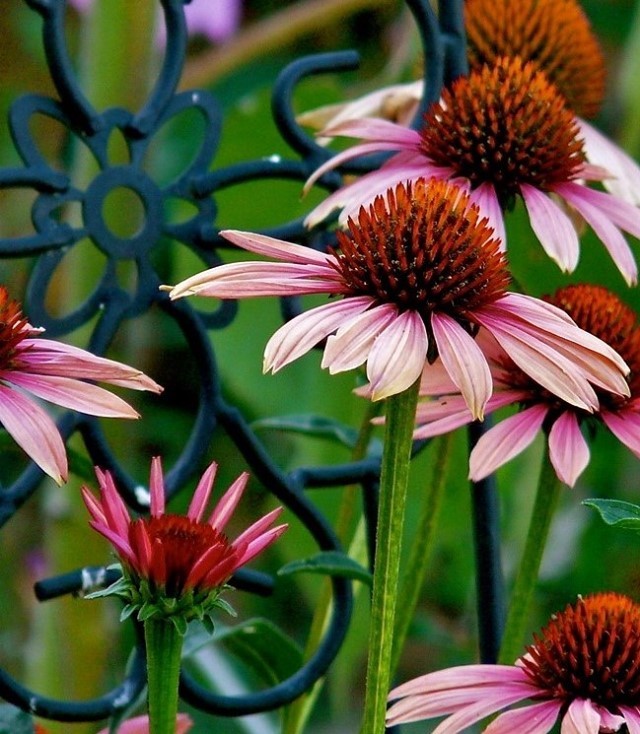
Purple Coneflower (Echinacea purpurea) stands out as Ohio’s premier wildflower species, native to eastern North America and thriving throughout the state’s diverse landscapes. This hardy herbaceous perennial produces distinctive daisy-like flowers with vibrant purple petals surrounding prominent copper-orange central cones, blooming from early summer through autumn.
Reaching heights up to 4 feet, Purple Coneflower excels in both naturalized and cultivated settings. Its long-lasting, lightly-scented blooms attract butterflies and native bees while providing late-season seeds for birds. The plant’s drought tolerance, deer resistance, and low-maintenance nature make it invaluable for pollinator gardens and prairie restorations across Ohio. Beyond its ornamental value, Purple Coneflower has been valued for its medicinal properties, with extracts traditionally used to support immune function and act as a natural antibiotic.
- Hardiness: Zones 3-8, well-suited for Ohio’s climate
- Light: Full sun to partial shade; prefers at least 6 hours direct sunlight
- Water: Drought tolerant once established; requires consistent moisture first year
- Soil: Well-drained sandy, loamy, or clay soils; tolerates pH 6.5-7.0
- Fertilizer: Low requirements; thrives in average garden soil
- Pest/Disease Resistance: Excellent deer resistance; generally disease-free
- Growth Rate: Moderate; reaches mature size in 2-3 years
Wild Lupine (Lupinus Perennis)

Wild Lupine is a striking native perennial that grows up to 2 feet tall, producing spectacular elongated clusters of blue to purple pea-like flowers from April through July. This adaptable wildflower features compound palmate leaves and distinctive two-toned blooms that can reach 8 inches long. As an important pollinator plant, Wild Lupine provides essential nectar for butterflies and bees while thriving in Ohio’s sandy soils and open woodland areas.
Once established, Wild Lupine spreads naturally through short rhizomes and self-seeding, making it perfect for naturalized gardens, woodland edges, and native plant landscapes. Its hairy seed pods contain 2-7 seeds that disperse naturally, helping this low-maintenance wildflower colonize suitable areas throughout USDA zones 3-8. This beneficial wildflower also fixes atmospheric nitrogen, enhancing soil fertility naturally.
- Hardiness: USDA zones 3-8, prefers cooler evening temperatures
- Light: Full sun in cooler climates, partial shade in hotter regions
- Water: Low to moderate; drought tolerant once established
- Soil: Well-drained, acidic (pH below 6.8), sandy or loamy soils preferred
- Fertilizer: Low fertility requirements; avoid rich soils
- Pest/Disease Resistance: Generally resistant with few serious issues
- Growth Rate: Moderate; may be short-lived but readily self-seeds
Black-Eyed Susan (Rudbeckia Hirta)
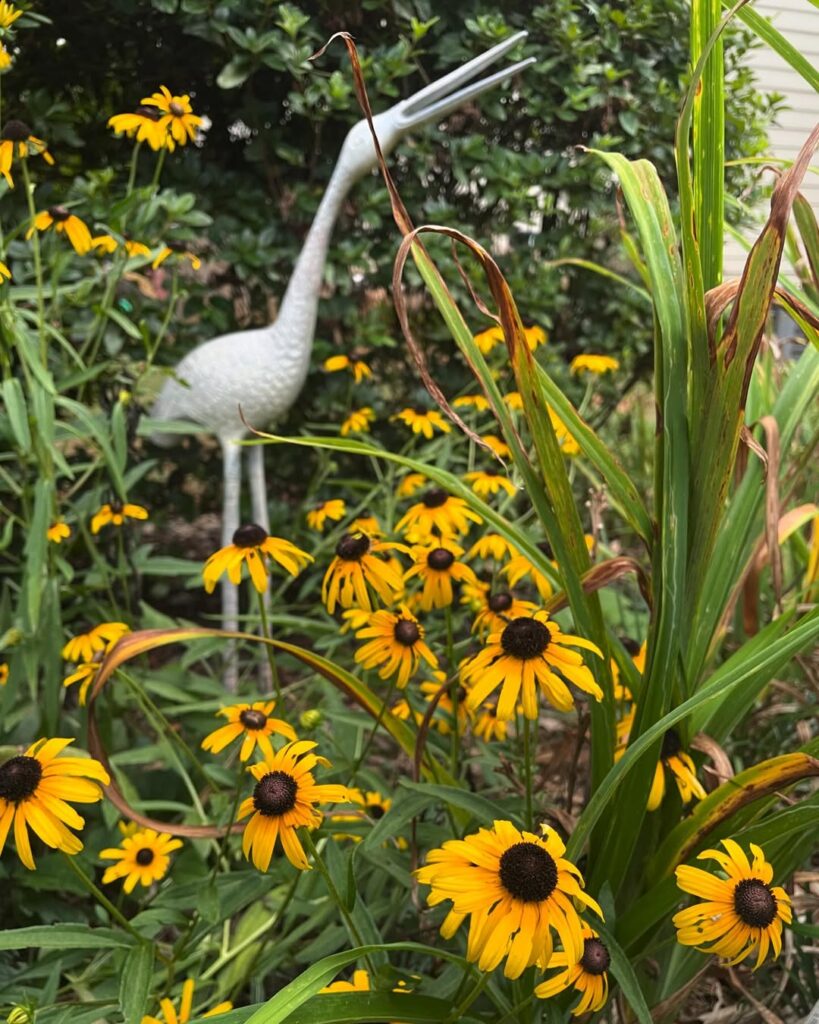
Black-Eyed Susan (Rudbeckia hirta) stands out as Ohio’s premier wildflower species, earning recognition for its vibrant golden-yellow blooms and exceptional adaptability. This hardy native herb grows up to 3 feet tall with classic daisy-like flowers measuring 2-3 inches wide, featuring the characteristic dark center that gives it its common name.
Functioning as an annual, biennial, or short-lived perennial, Black-Eyed Susan blooms from July through August and sometimes into early fall. Its drought tolerance, low maintenance requirements, and ability to thrive in various soil conditions make it an ideal choice for Ohio gardeners seeking native plants that support local ecosystems while providing consistent seasonal color. The flowers produce cypselae seeds that mature 3-4 weeks after the bloom period, allowing for natural propagation and garden expansion.
- Hardiness: Native warm-season plant, hardy and adaptable to Ohio conditions east of the Rocky Mountains
- Light: Full sun preferred, tolerates partial shade
- Water: Low to moderate water requirements, drought tolerant once established, prefers dry to slightly moist conditions
- Soil: Well-drained clayey loam to sandy loam soils, tolerates various soil types including silt loam, pH 6.0-7.5
- Fertilizer: Acts as nitrogen fixer, improving soil fertility naturally, minimal fertilizer needs
- Pest/Disease Resistance: Hardy native species with good natural resistance
- Growth Rate: Moderate growth rate, blooms for up to a month during peak season
New England Aster (Symphyotrichum Novae-Angliae)
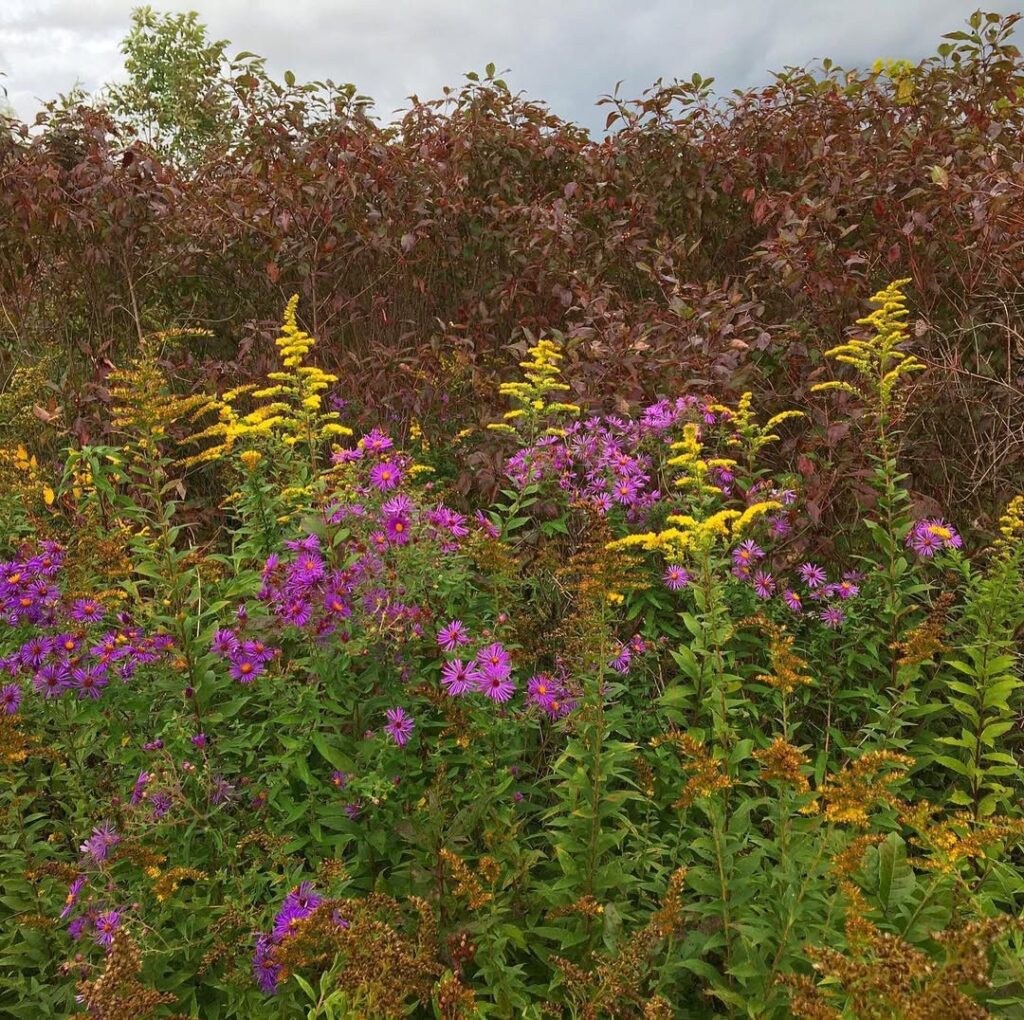
New England Aster (Symphyotrichum novae-angliae) stands as one of Ohio’s most spectacular native wildflowers, reaching heights up to 6 feet with distinctive hairy stems and clasping leaves. This late-blooming perennial produces masses of showy rose-purple flowers with bright orange-yellow centers from August through October, though color variations include lavender, blue, pink, and white.
As a critical late-season pollinator plant, New England Aster provides essential nectar when most other flowers have finished blooming, making it particularly valuable for monarch butterflies and other pollinators. The plant also serves as a larval host for Pearl Crescent and checkerspot butterflies, supporting their complete life cycle. Its adaptability to various growing conditions and deer resistance make it an excellent choice for naturalizing in Ohio landscapes, from prairies and meadows to woodland edges.
- Hardiness: Zones 4-8, native to eastern North America including Ohio
- Light: Full sun to light shade
- Water: Moderate to moist conditions; drought tolerant once established
- Soil: Adaptable to broad range of soil types; prefers moist, rich soils
- Fertilizer: Low maintenance; thrives without supplemental fertilization
- Pest/Disease Resistance: Deer resistant; generally pest and disease free
- Growth Rate: Moderate to fast; forms colonies over time
Ohio’s Shade and Canopy Trees
Ohio’s diverse native shade trees include majestic oaks, distinctive hickories, graceful elms and beeches, plus specialized birches—each offering unique characteristics for creating cool, wildlife-supporting canopies. These towering trees provide essential habitats for numerous wildlife species while delivering crucial ecosystem services to Ohio’s landscapes.
Ohio Buckeye (Aesculus Glabra)
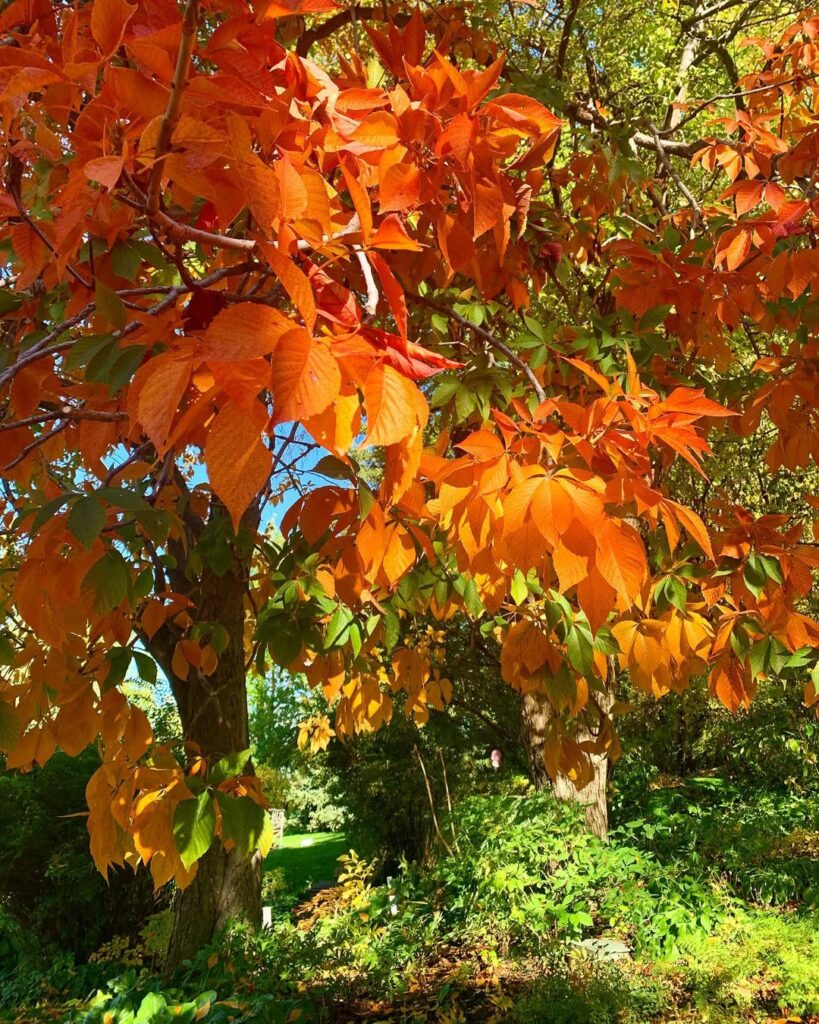
The Ohio Buckeye (Aesculus glabra) is Ohio’s official state tree, a native deciduous species known for its distinctive palmately compound leaves and shiny brown seeds with pale “eyes.” This medium-sized tree creates excellent shade with its rounded canopy and dense foliage, typically reaching 20-40 feet in height.
Notable for its early spring clusters of greenish-yellow flowers and ornamental fall seed capsules, the Ohio Buckeye serves as both a specimen and canopy tree. Its deep taproot system and tolerance for various soil conditions make it well-suited for permanent landscape installations, though all parts of the plant are toxic if ingested. The flowers are particularly attractive to hummingbirds and butterflies, making it a valuable choice for wildlife-friendly landscapes.
- Hardiness: USDA Zones 3-7
- Light: Full sun to partial shade
- Water: Moderate; prefers moist, well-drained soils but tolerates some drought
- Soil: Adaptable to various soil types including alkaline and clay-rich soils; prefers well-drained conditions
- Fertilizer: Low maintenance; typically doesn’t require supplemental fertilization in native soils
- Pest/Disease Resistance: Generally resistant to deer browsing due to toxicity; may experience leaf scorch in drought conditions
- Growth Rate: Moderate
Red Oak (Quercus Rubra)

Red Oak (Quercus rubra) is a magnificent native hardwood tree that serves as a cornerstone species in Ohio’s forests. This fast-growing oak can reach impressive dimensions of 60 feet tall and 70 feet wide, forming a broad, rounded crown that provides excellent shade. Its dark green summer foliage transforms to vibrant red in fall, creating stunning seasonal displays.
Beyond its ornamental value, Red Oak plays an essential ecological role in Ohio’s forest ecosystems. The tree produces acorns that feed deer, turkey, squirrels, and numerous bird species, while its foliage hosts many native caterpillars and insects. The acorns require 18 months to fully mature on the tree before they become available as wildlife food. With a lifespan of 200-300 years, Red Oak contributes to long-term forest stability and canopy structure, making it an invaluable addition to both natural landscapes and managed plantings.
- Hardiness: USDA Zones 3-7
- Light: Full sun preferred; tolerates partial shade when young
- Water: Moderate moisture; tolerates drought once established
- Soil: Well-drained, slightly acidic sandy loam preferred; adapts to clay, loam, sandy, gravelly, neutral, or slightly alkaline soils
- Fertilizer: Generally not required; thrives in native soil conditions
- Pest/Disease Resistance: Good resistance; susceptible to minor insect feeding and common oak pests but generally problem-free
- Growth Rate: Fast-growing
Sugar Maple (Acer Saccharum)
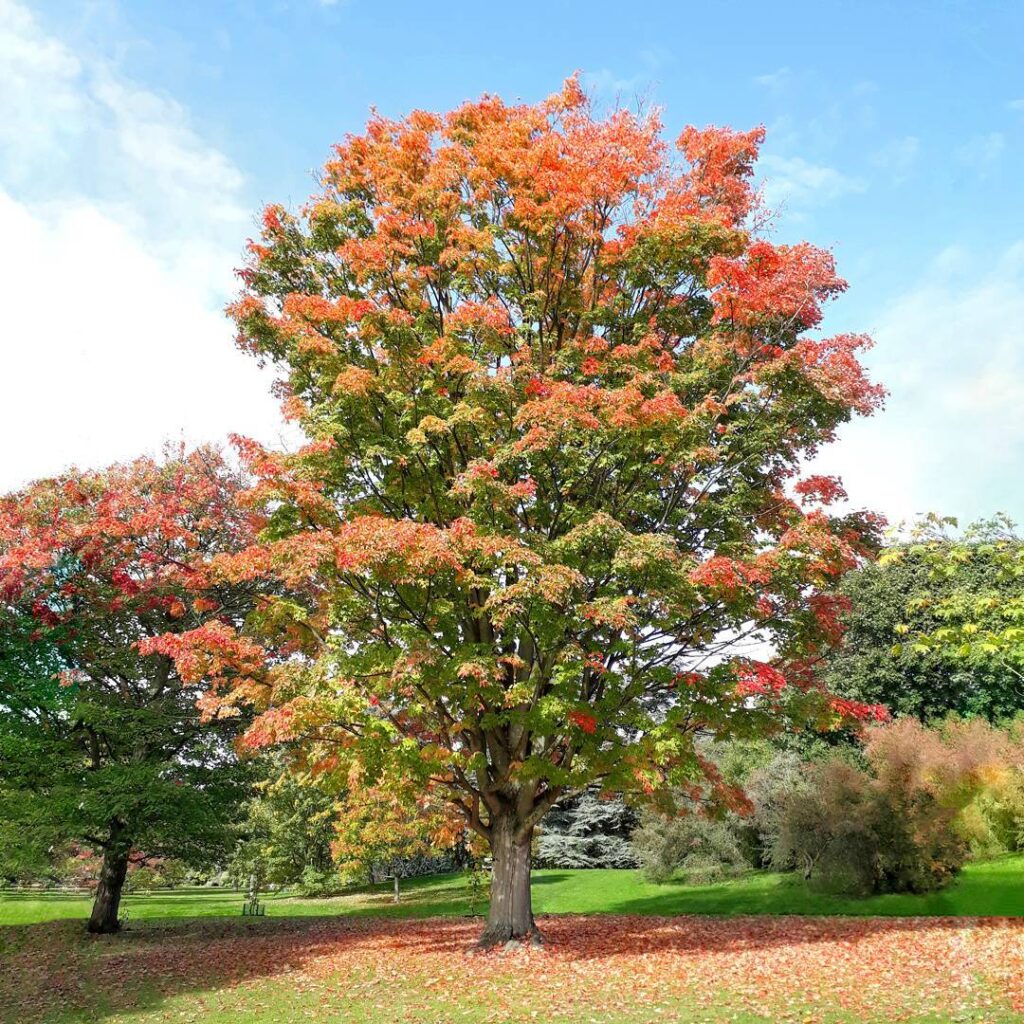
The Sugar Maple (Acer saccharum) stands as one of Ohio’s most magnificent native shade trees, capable of reaching 70-100 feet in height and living up to 200 years. This slow-growing deciduous tree creates dense canopies that provide excellent shade while supporting Ohio’s native wildlife through its seeds and foliage.
Renowned for its spectacular fall colors ranging from yellow to orange and red, the Sugar Maple produces chartreuse flowers in spring and distinctive winged seeds. Its dense shade makes it ideal for large open spaces like parks and expansive lawns, though few plants can grow beneath its canopy except spring wildflowers. As one of the most shade-tolerant large deciduous trees, it can germinate and persist even under closed forest canopies.
- Hardiness: USDA zones 3-8, well-adapted to Ohio’s climate
- Light: Full sun to partial shade, prefers open spaces
- Water: Moderate moisture requirements, drought sensitive when young
- Soil: Well-drained, fertile soils; shallow to moderately deep root system
- Fertilizer: Generally not required in native settings with adequate soil
- Pest/Disease Resistance: Good resistance, browsed by deer in natural areas
- Growth Rate: Slow compared to other native trees
American Basswood (Tilia Americana)

American Basswood (Tilia americana) is a majestic native deciduous tree that serves as an excellent canopy species for Ohio landscapes. Reaching heights of 75-130 feet with a dense, rounded crown, this “Bee-tree” produces fragrant flowers that attract pollinators and support honey production. The tree features large, broadly oval leaves that turn yellow-brown in fall and develops hard, nut-like fruits. Basswood readily sprouts from its base, often forming attractive multi-trunk specimens.
This versatile shade tree thrives in Ohio’s varied woodland conditions, from moist lowlands to drier upland sites. Its soft, light wood has been valued for centuries, while the inner bark was historically used by Native Americans for rope and weaving. Basswood provides excellent wildlife habitat, offering food through its seeds and young shoots while creating nesting opportunities for various species. The tree’s mucilaginous sap can be harvested and processed into a sweet syrup for culinary use.
- Hardiness: Zones 3-8, tolerates continental climates with cold winters
- Light: Full sun to partial shade
- Water: Moist, well-drained conditions preferred; moderate drought tolerance once established
- Soil: Deep, fertile loam preferred; pH 4.5-7.5; requires adequate nitrogen
- Fertilizer: Benefits from nitrogen supplementation in poor soils
- Pest/Disease Resistance: Generally healthy; susceptible to urban air pollution
- Growth Rate: Moderate to fast growth rate
Eastern Redbud (Cercis Canadensis)
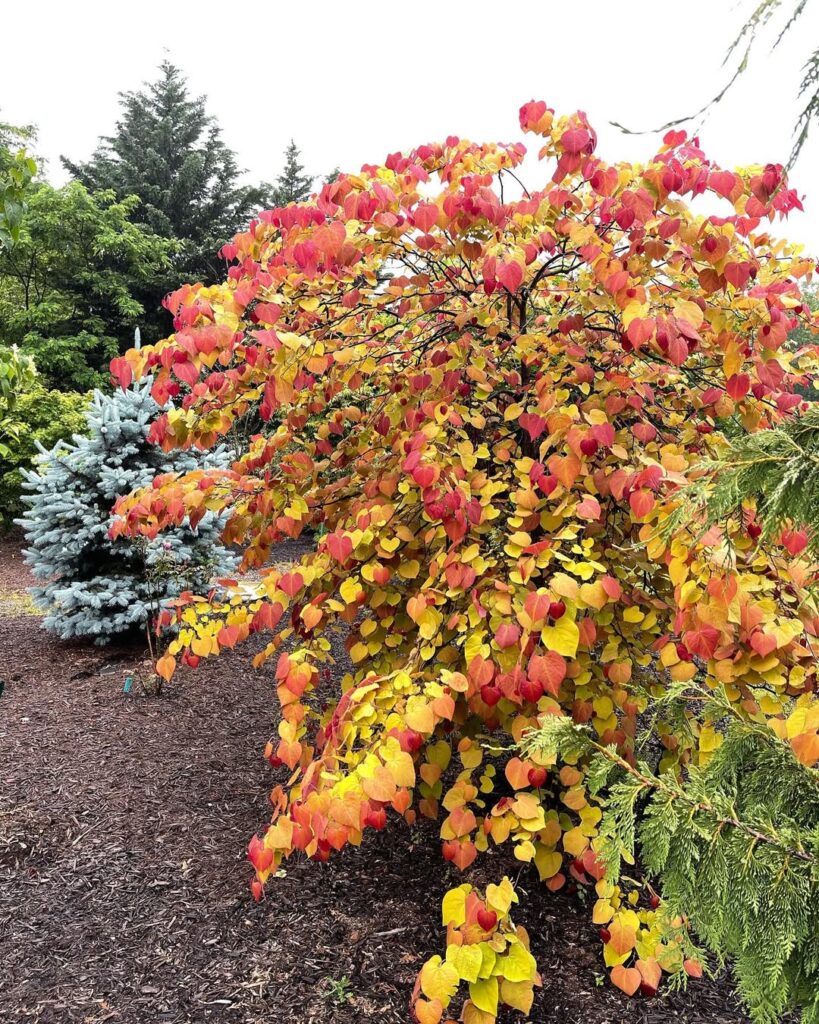
The Eastern Redbud is a versatile native tree perfect for Ohio landscapes, growing 20-30 feet tall with an attractive spreading crown. This deciduous beauty produces stunning magenta-pink flowers in early spring before leaves emerge, creating spectacular seasonal interest. The distinctive heart-shaped leaves and compact size make it ideal for smaller properties and ornamental plantings.
Eastern Redbud thrives in Ohio’s changing zones, particularly at forest edges where it supports diverse wildlife. Its early blooms provide essential nectar for native bees, while the bean-like seed pods offer food for birds and small mammals. The tree forms a symbiosis with nitrogen-fixing actinomycetota Frankia, leading to nitrogen-fixing root nodules that benefit soil health. The tree adapts well to various growing conditions but performs best in partial shade with consistent moisture.
- Hardiness: Zones 4-9, well-suited to Ohio climate
- Light: Partial shade to full sun; best performance in partial shade
- Water: Moderate to high water needs; prefers consistent moisture, low drought tolerance
- Soil: Rich, moist, well-draining soils; pH 6.0-8.0; thrives in alkaline, calcareous soils
- Fertilizer: Low requirements in rich soils; benefits from organic matter
- Pest/Disease Resistance: Generally good resistance; may experience minor issues in stressed conditions
- Growth Rate: Medium; reaches approximately 16 feet in 10 years
Ohio’s Understory Shrub Champions
Ohio’s native understory shrubs create essential wildlife habitat while adding multi-season beauty to landscapes. These adaptable champions excel in diverse conditions from shaded woodlands to sunny borders. Individual spaces like backyards provide vital habitat connectivity for birds, butterflies, and beneficial pollinators that depend on native plants for survival.
Spicebush (Lindera Benzoin)

Spicebush (Lindera benzoin) stands out as one of Ohio’s premier native understory shrubs, perfectly adapted to the region’s woodland environments. This deciduous shrub typically reaches 6-8 feet in height and width, though it can grow up to 12 feet under ideal conditions. Named for the sweet, spicy fragrance released when its stems or leaves are crushed, spicebush offers exceptional value to both wildlife and gardeners.
The shrub produces small greenish-yellow flowers in early spring before the leaves emerge, followed by bright red oval berries in fall that provide essential food for migrating birds. Its simple, light green leaves transform to brilliant golden yellow in autumn, creating stunning seasonal interest. Spicebush serves as an important host plant for Spicebush Swallowtail butterflies and Promethea Silkmoth larvae while remaining deer-resistant, making it a perfect choice for naturalized landscapes and woodland gardens throughout Ohio. As a member of the Lauraceae family, spicebush shares characteristics with other aromatic plants like bay laurel and sassafras.
- Hardiness: USDA zones 4-9, well-suited for Ohio’s climate
- Light: Full shade to partial sun, excellent shade tolerance
- Water: Medium moisture requirements, drought tolerant once established
- Soil: Adaptable to sandy, loamy, or clay soils with slightly acidic pH 4.5-6
- Fertilizer: Generally requires no supplemental fertilization in native settings
- Pest/Disease Resistance: Naturally resistant to most pests and diseases, deer resistant
- Growth Rate: Moderate growth rate, reaching mature size in 5-10 years
Elderberry (Sambucus Canadensis)
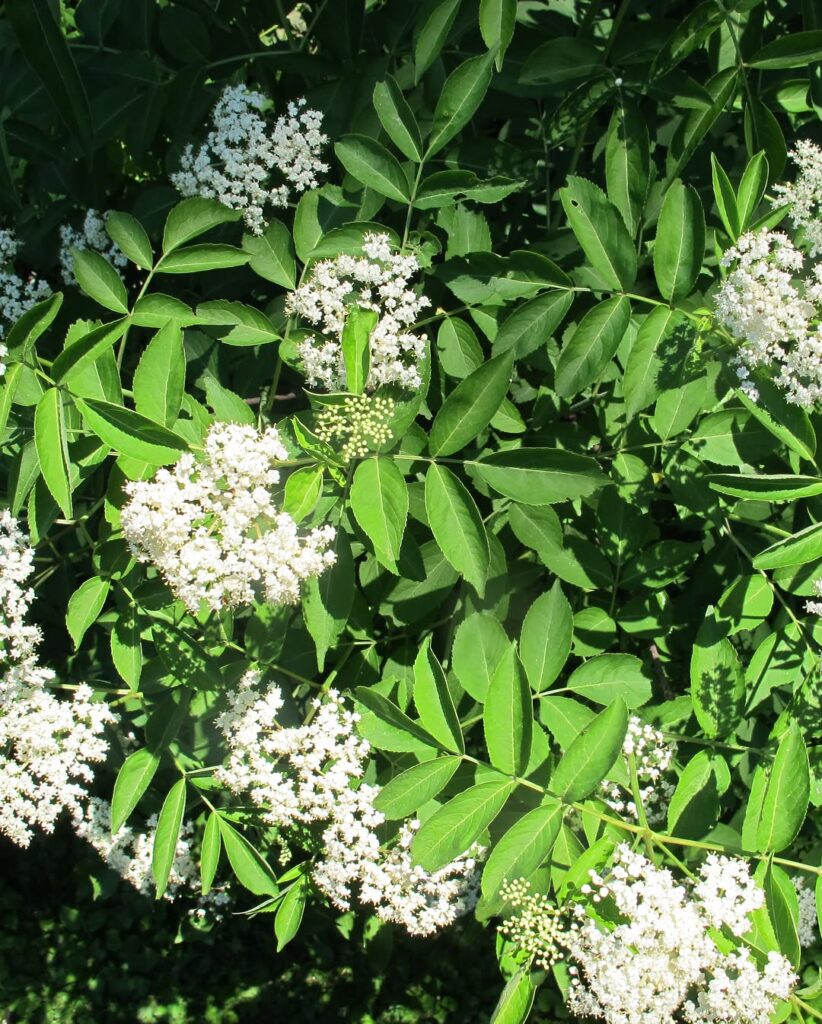
Elderberry is a versatile woody shrub native to eastern and central North America, including Ohio. This multi-stemmed plant grows 5-12 feet tall and wide, forming dense thickets through prolific suckering. It produces clusters of creamy white flowers in late spring that attract pollinators, followed by dark purple berries that wildlife enthusiastically consume. The edible flowers and cooked berries have traditional culinary and medicinal uses, though raw plant parts contain toxic compounds.
This adaptable shrub thrives in various conditions from wet ditches to dry fields, making it excellent for restoration projects and native landscaping. Its rapid establishment and wildlife value make elderberry a champion of Ohio’s understory, providing food and shelter while requiring minimal maintenance once established. Elderberry is commonly found growing alongside Silky Dogwoods and other native species in Ohio’s natural landscapes.
- Hardiness: USDA Zones 4a-8b
- Light: Full sun for best fruit production; tolerates partial shade
- Water: Adaptable from well-drained to occasionally wet conditions; prefers consistent moisture
- Soil: Clay, loam, sand, or high organic matter; pH 6.0-8.0 preferred
- Fertilizer: Low requirements; benefits from organic matter
- Pest/Disease Resistance: Generally resistant with few serious issues
- Growth Rate: Medium to fast; forms hedges within 2-3 years
Ninebark (Physocarpus Opulifolius)
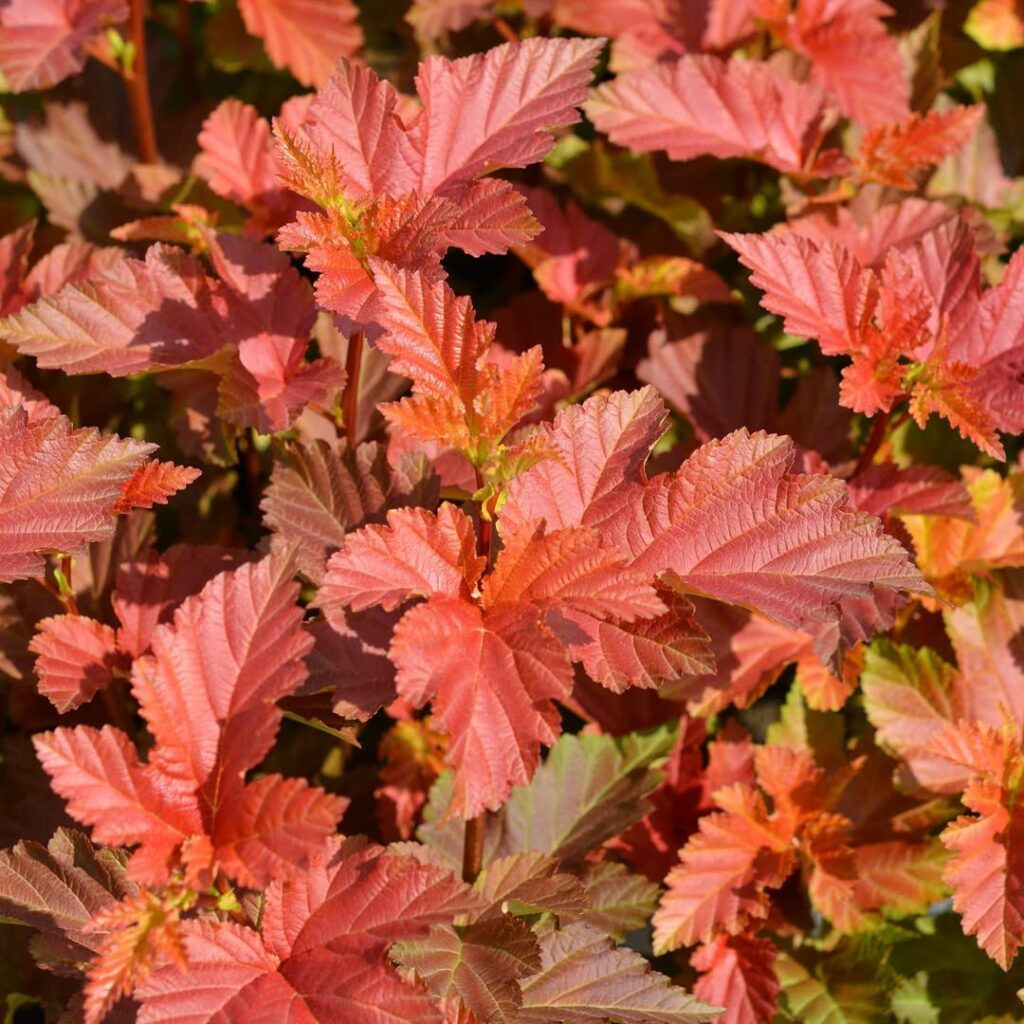
Ninebark (Physocarpus opulifolius) is a versatile native understory shrub that exemplifies the resilience and beauty of Ohio’s woodland plants. Growing 3-10 feet tall with an attractive mound-shaped, arching form, this durable shrub offers multi-season interest through its exfoliating bark, colorful foliage ranging from chartreuse to deep purple, and clusters of white-pinkish spring flowers.
Beyond its ornamental value, ninebark serves as an ecological powerhouse, supporting 36 species of Lepidoptera caterpillars and providing essential early-season nectar for native bees and honey bees. Its persistent fruit pods feed birds and small mammals while offering dense nesting cover. This low-maintenance champion thrives in challenging conditions from wet to dry sites, making it ideal for sustainable landscaping, erosion control, and restoration projects. The shrub can be easily propagated from fall-sown seed or semi-hardwood cuttings, allowing gardeners to expand their plantings or share with neighbors.
- Hardiness: Zones 2-7, extremely cold hardy and heat tolerant
- Light: Full sun to partial shade, adaptable to wide range of light conditions
- Water: Drought tolerant once established, tolerates both wet and dry conditions
- Soil: Adaptable to clay, loam, and poor soils; prefers pH 6.8-7.2 but tolerates wide range
- Fertilizer: Minimal inputs needed; grows best when not over-fertilized
- Pest/Disease Resistance: Excellent resistance, generally free of serious issues
- Growth Rate: Fast growing, establishes quickly in landscape
Serviceberry (Amelanchier Canadensis)
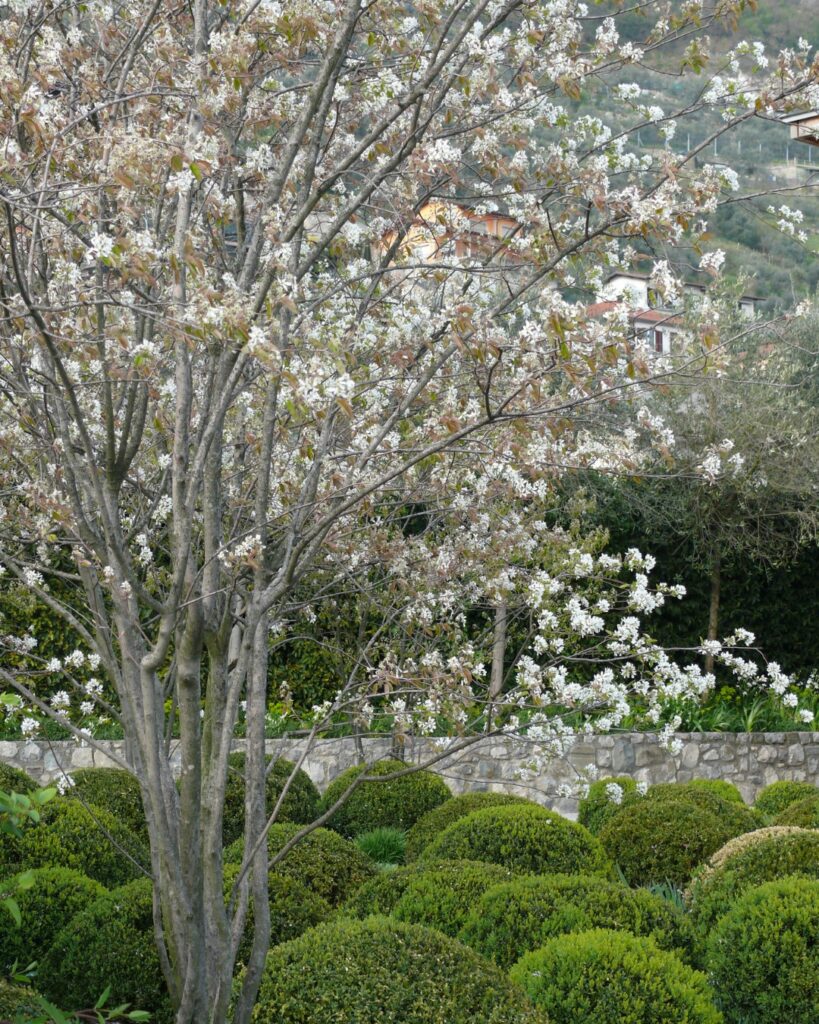
Serviceberry (Amelanchier canadensis) stands out as one of Ohio’s premier understory shrubs, offering exceptional four-season value in native landscapes. This multi-stemmed deciduous shrub reaches 4-15 feet tall, producing delicate white flower clusters in early spring before leaves emerge, followed by sweet purplish-red to black fruits in summer.
Beyond its ornamental appeal, serviceberry serves as vital wildlife habitat, providing early nectar for native pollinators, summer fruit for birds and mammals, and host plants for native moths and butterflies. The brown-red twigs often display a distinctive zig-zag pattern, particularly in slower-growing sections, adding winter architectural interest to the landscape. Its adaptability to diverse conditions—from streambanks to drier upland sites—makes it invaluable for rain gardens, naturalized borders, and understory plantings throughout Ohio’s varied landscapes.
- Hardiness: USDA zones 4-9
- Light: Partial shade to full sun
- Water: Moderate; tolerates both moist and drier conditions
- Soil: Well-drained to seasonally moist; adapts to wide range of soil types
- Fertilizer: Low requirements; thrives in native soils
- Pest/Disease Resistance: High; low susceptibility to most pests and diseases
- Growth Rate: Moderate
Dogwood (Cornus Florida)
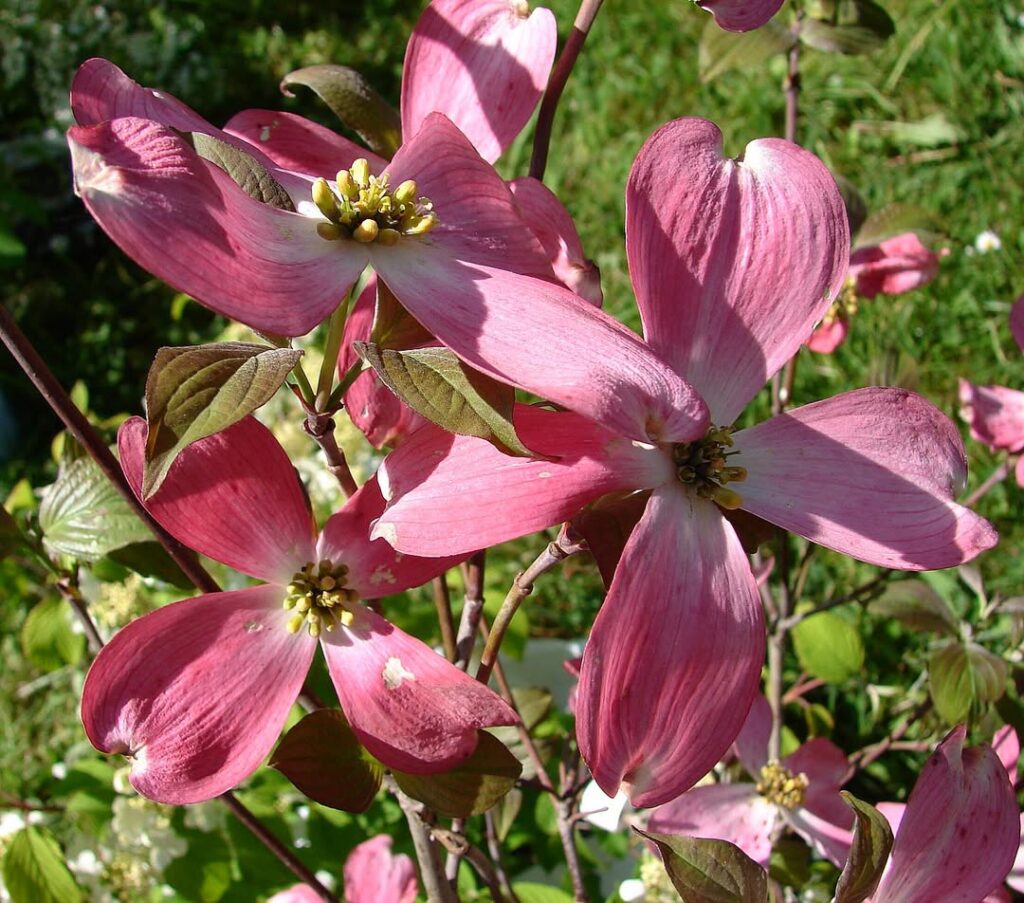
Dogwood (Cornus florida) stands as one of Ohio’s most beloved understory trees, offering exceptional four-season appeal in woodland settings. This native species typically reaches 10-13 feet in Ohio, developing a spreading, layered branching structure that creates natural elegance in forest understories. Its spring display of white to pink bracts, followed by red fall fruits and crimson autumn foliage, makes it a cornerstone species for Ohio’s native plant landscapes.
As a true understory champion, dogwood thrives in Ohio’s woodland edges and partially shaded areas where it provides critical habitat for wildlife. Its shallow root system and preference for consistent moisture make it well-adapted to woodland soils but sensitive to drought and soil disturbance. The wood’s exceptional shock resistance has historically made it valuable for crafting tool handles and specialized equipment.
- Hardiness: Zones 5-9, well-suited to Ohio’s climate
- Light: Partial sun to full shade; prefers partial sun for ideal flowering
- Water: Consistent moisture required; drought sensitive due to shallow roots
- Soil: Well-drained, acidic soils (pH 6-7); struggles in alkaline or compacted conditions
- Fertilizer: Minimal requirements in natural woodland settings
- Pest/Disease Resistance: Moderate; can be susceptible to anthracnose and borers
- Growth Rate: Slow to moderate growth
Selecting the Right Native Plants for Your Garden
How do you choose native plants that’ll actually thrive in your Ohio garden instead of limping along like homesick tourists? Start by evaluating your site’s soil, drainage, and sun exposure. Match plant needs to these conditions precisely.
Consider your garden design goals and available space. Purple Coneflower reaches 3-4 feet, while Wild Ginger stays under 6 inches. Plan companion planting with varying bloom times for continuous color from spring through fall.
Select species from Ohio’s ecoregions with high wildlife value. Combine flowering forbs, grasses, and shrubs in natural groupings. Source plants from reputable native nurseries, avoiding cultivars when possible for maximum ecological benefits. Ohio’s native plant kits offer themed collections that simplify selection by grouping compatible species for specific growing conditions and garden goals.
Frequently Asked Questions
Where Can I Buy Native Ohio Plants Locally?
You’ll find variety, you’ll find quality, you’ll find expertise at local nurseries like Natives in Harmony, Wild Hare Prairie, and Cahoon Nursery. Online retailers and specialty sources also offer native Ohio plants.
When Is the Best Time to Plant Native Species in Ohio?
You’ll find ideal planting windows in late March through early May and late August through mid-October. These seasonal considerations allow native species to establish properly before Ohio’s summer heat or winter dormancy periods arrive.
How Do I Control Invasive Species Competing With My Native Plants?
You’ll discover that effective invasive species control methods work best when you cut stems and treat stumps with herbicide, hand-pull smaller plants, and promptly replace removed invasives with native alternatives.
What Native Plants Attract Butterflies and Hummingbirds in Ohio?
You’ll want cardinal flower, bee balm, and wild columbine for butterfly gardens and hummingbird feeders. Add native host plants like oaks and spicebush to support caterpillars, ensuring continuous blooms throughout Ohio’s growing season.
How Much Water Do Established Native Ohio Plants Typically Need?
Established native Ohio plants have minimal water requirements due to their excellent drought tolerance. You’ll typically need to water them every 3-4 weeks during summer months, as they’ve adapted to Ohio’s natural precipitation patterns.
